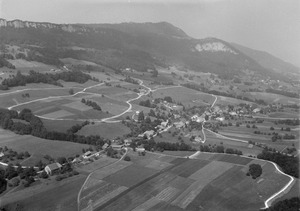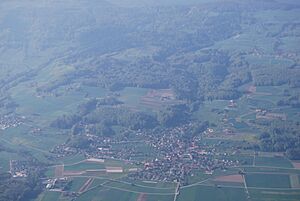Farnern facts for kids
Quick facts for kids
Farnern
|
||
|---|---|---|
|
||
| Country | Switzerland | |
| Canton | Bern | |
| District | Oberaargau | |
| Area | ||
| • Total | 3.68 km2 (1.42 sq mi) | |
| Elevation | 800 m (2,600 ft) | |
| Population
(Dec 2020 )
|
||
| • Total | 227 | |
| • Density | 61.68/km2 (159.8/sq mi) | |
| Postal code |
4539
|
|
| Surrounded by | Aedermannsdorf (SO), Attiswil, Günsberg (SO), Herbetswil (SO), Rumisberg | |
Farnern is a small town, also called a municipality, located in Switzerland. It is part of the Bern area, known as a canton, and is found in the Oberaargau district.
Contents
Farnern's Past: A Look at Its History
Farnern was first written about in the year 1329. Back then, it was called Varnerron.
The oldest signs of people living here are some old coins. These coins are from the Iron Age and the Roman era. They were found near places called Schmiedenmatt and Bettlerküche. People think these coins were offerings to a special place of worship in the nearby mountains.
During the Middle Ages, Farnern was part of a larger area called Oberbipp. When the city of Bern took over Oberbipp, Farnern became part of Bern's land. It was also part of the church area, or parish, of Oberbipp.
For a long time, farmers in Farnern grew just enough food for themselves. This is called subsistence farming. They also grew a few extra crops to sell. In the 1800s, they started raising more cattle for meat and milk. By 1876, there were enough dairy farmers to have a local dairy and cheese factory.
Today, farming still provides about half of the jobs in Farnern. However, most people now travel to bigger towns like Solothurn for work. Because fewer children were joining the local school, Farnern teamed up with two other towns in 1975. They formed a school district together.
Exploring Farnern's Geography
Farnern covers an area of about 3.7 square kilometers (1.4 square miles). A big part of this land, about 64.8%, is used for farming. Forests cover about 29.8% of the area. The rest, about 4.3%, has buildings and roads.
More specifically, 2.4% of the land has houses and other buildings. Roads and other ways to travel make up 1.9%. About 26% of the land is covered with thick forests. Small groups of trees or orchards cover 3.8%.
For farming, 9.2% of the land is used for growing crops. Pastures for animals make up 25.5%. Orchards or vineyards use 2.2%, and mountain pastures are 27.9%.
The town is built on a flat area on the southern side of the Jura Mountains. Farnern village is here, along with many scattered farmhouses.
In 2010, Farnern became part of a new administrative area called Verwaltungskreis Oberaargau. This happened after its old district, Amtsbezirk Wangen, was closed.
Understanding Farnern's Coat of Arms
The coat of arms for Farnern has a special design. It shows three green fern leaves growing from a green hill. The background is silver.
This design is an example of "canting arms". This means the picture on the shield gives a hint about the name of the place. In this case, "Farnern" sounds a bit like "fern," which is shown on the arms.
Who Lives in Farnern? Demographics
Farnern has a population of about 207 people (as of December 2012). A small part of the population, about 7.2%, are people from other countries. Between 2010 and 2012, the number of people living in Farnern grew by 2.5%.
Most people in Farnern (about 98.6%) speak German as their main language. A few people speak French.
In 2013, about 47.8% of the people were boys and men, and 52.2% were girls and women. Most people living in Farnern were born in Switzerland. About 34.8% were born right in Farnern.
When we look at age groups (as of 2012):
- Children and teenagers (0–19 years old) make up 16.9% of the population.
- Adults (20–64 years old) make up 57.0%.
- Seniors (over 64 years old) make up 26.1%.
In 2010, there were 22 homes where only one person lived. Only one home had five or more people. Most apartments in Farnern are lived in all the time.
Here is a chart showing how Farnern's population has changed over the years:

Farnern's Economy: Jobs and Work
In 2011, Farnern had a low unemployment rate of 1.81%. This means most people who wanted jobs had them. A total of 75 people worked in the town.
Jobs are often grouped into three main types:
- Primary sector: This includes jobs like farming and forestry. In Farnern, 35 people worked in this area, mostly in agriculture.
- Secondary sector: This includes jobs in factories and making things. Only 2 people worked in this sector in Farnern.
- Tertiary sector: This includes jobs that provide services, like shops, restaurants, or schools. In Farnern, 38 people worked in this sector.
Many people who live in Farnern travel to other towns for work. In 2000, 90 people left Farnern for their jobs, while only 12 came into Farnern to work. About 73.9% of the workers in Farnern also lived there.
Most people (61.3%) use a private car to get to work. About 9.7% use public transportation, like buses or trains.
Religious Life in Farnern
Based on a survey from 2000, most people in Farnern belong to a Christian church.
- About 76.9% were part of the Swiss Reformed Church.
- About 9.0% were Roman Catholic.
- A small number (0.90%) belonged to the Christian Catholic Church.
About 12.67% of the people said they did not belong to any church. Some of these might be agnostic (not sure if God exists) or atheist (do not believe in God).
Learning in Farnern: Education
Many people in Farnern have a good education. About 61.5% have finished high school, which is called "upper secondary education" in Switzerland. About 17.9% have gone on to higher education, like a university.
The school system in the Canton of Bern works like this:
- One year of optional Kindergarten.
- Six years of Primary school.
- Three years of mandatory lower Secondary school. Students are grouped by their abilities.
- After secondary school, students can continue their studies or start an apprenticeship (learning a trade on the job).
During the 2012–13 school year, 18 students attended classes in Farnern. All of them were in German-speaking kindergarten classes. Some of these students were from other countries or had a different first language. The primary school also had 18 students.
In 2000, 21 students went to school in Farnern. Seven of them lived and went to school in the town. The other 14 came from nearby towns. Also, 20 students from Farnern went to schools outside the town.
See also
 In Spanish: Farnern para niños
In Spanish: Farnern para niños






